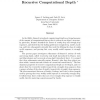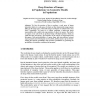54 search results - page 2 / 11 » Five deep questions in computing |
ICALP
1997
Springer
13 years 9 months ago
1997
Springer
In the 1980's, Bennett introduced computational depth as a formal measure of the amount of computational history that is evident in an object's structure. In particular,...
COLING
2010
13 years 18 days ago
2010
This paper presents a novel semisupervised learning algorithm called Active Deep Networks (ADN), to address the semi-supervised sentiment classification problem with active learni...
DSSCV
2005
Springer
13 years 11 months ago
2005
Springer
We face the question of how to produce a scale space of image intensities relative to a scale space of objects or other characteristic image regions filling up the image space, whe...
SIGDIAL
2010
13 years 3 months ago
2010
A central problem in Interactive Question Answering (IQA) is how to answer Follow-Up Questions (FU Qs), possibly by taking advantage of information from the dialogue context. We a...
ACL
2009
13 years 3 months ago
2009
In this paper, we analyze the impact of different automatic annotation methods on the performance of supervised approaches to the complex question answering problem (defined in th...


